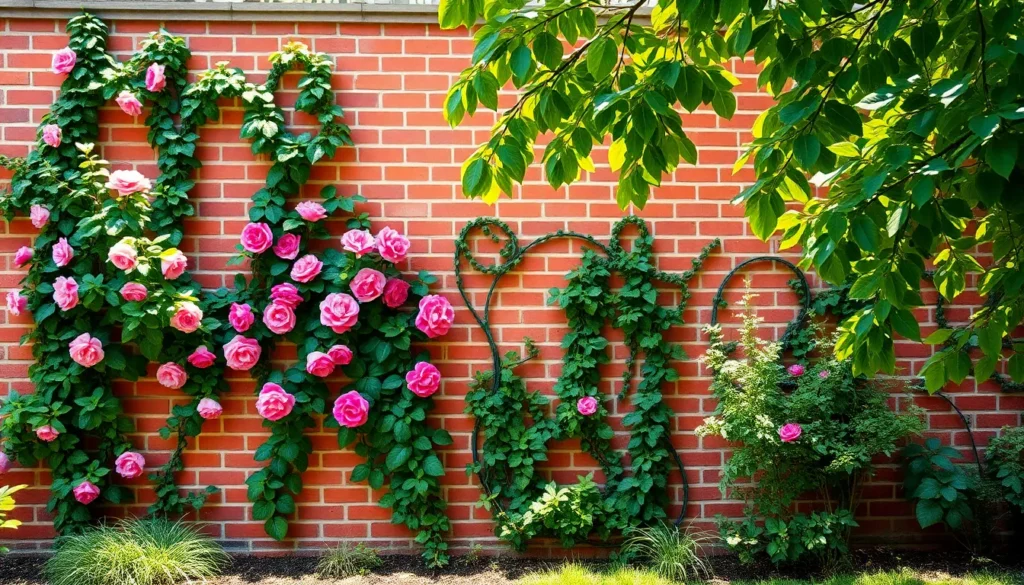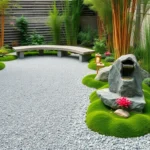When we’re looking to transform our outdoor spaces, brick walls offer the perfect blend of durability and timeless charm. These versatile structures can serve multiple purposes – from creating privacy and defining garden boundaries to building raised planters and decorative focal points that enhance our industry’s overall appeal.
We’ve discovered that brick walls aren’t just functional barriers; they’re design opportunities waiting to be explored. Whether you’re working with a sprawling backyard or a cozy urban garden, the right brick wall design can dramatically elevate your outdoor aesthetic while adding substantial value to your property.
From classic red brick patterns to modern painted finishes, we’ll explore creative ideas that suit every style preference and budget. Ready to discover how these sturdy structures can revolutionize your garden space? Let’s jump into inspiring brick wall concepts that’ll make your neighbors take notice.
Classic Red Brick Garden Wall Designs
Classic red brick remains the gold standard for garden wall construction, offering unmatched versatility and enduring charm that complements virtually any industry design.
Traditional English Garden Style
Traditional English garden walls showcase the timeless beauty of red brick through their characteristic weathered appearance and cottage garden charm. We’ve observed how these walls typically stand 3 to 5 feet tall, creating intimate garden rooms while maintaining an open, welcoming atmosphere. Reclaimed red bricks work exceptionally well for this style, bringing authentic character through their irregular surfaces and varied color tones.
English garden brick walls often incorporate climbing roses, ivy, and clematis that soften harsh lines while adding seasonal interest. The mortar joints in traditional designs are usually flush or slightly recessed, emphasizing the brick texture rather than the pointing. We recommend using lime mortar for authentic restoration projects, as it allows the wall to breathe naturally and prevents moisture damage over time.
Herringbone Pattern Applications
Herringbone brick patterns create striking visual interest through their distinctive zigzag arrangement that draws the eye along the wall’s length. We particularly favor this pattern for shorter decorative walls and raised planter borders where the intricate design can be fully appreciated. The herringbone layout requires approximately 15% more bricks than standard running bond patterns due to cutting requirements at the edges.
Installing herringbone patterns demands precise measurement and skilled craftsmanship to maintain consistent angles throughout the structure. Each brick sits at a 45 degree angle to create the interlocking V shaped pattern that gives herringbone its distinctive appearance. We’ve found this pattern works best on walls under 4 feet tall, as taller applications can appear overwhelming in residential garden settings.
Running Bond Layout Options
Running bond represents the most popular and practical brick laying pattern for garden walls, featuring offset joints that create exceptional structural strength. We consistently recommend this layout for walls over 4 feet tall due to its superior load bearing capabilities and resistance to settling. The pattern uses approximately 6.5 standard bricks per square foot, making material calculation straightforward for planning purposes.
Standard running bond offsets each course by half a brick length, creating the familiar staggered appearance seen in most residential construction. We often suggest incorporating header courses every sixth or seventh row to add visual interest while maintaining structural integrity. This classic pattern works seamlessly with both new and reclaimed red bricks, adapting beautifully to curved walls and corner applications without compromising strength or appearance.
Modern Minimalist Brick Wall Concepts
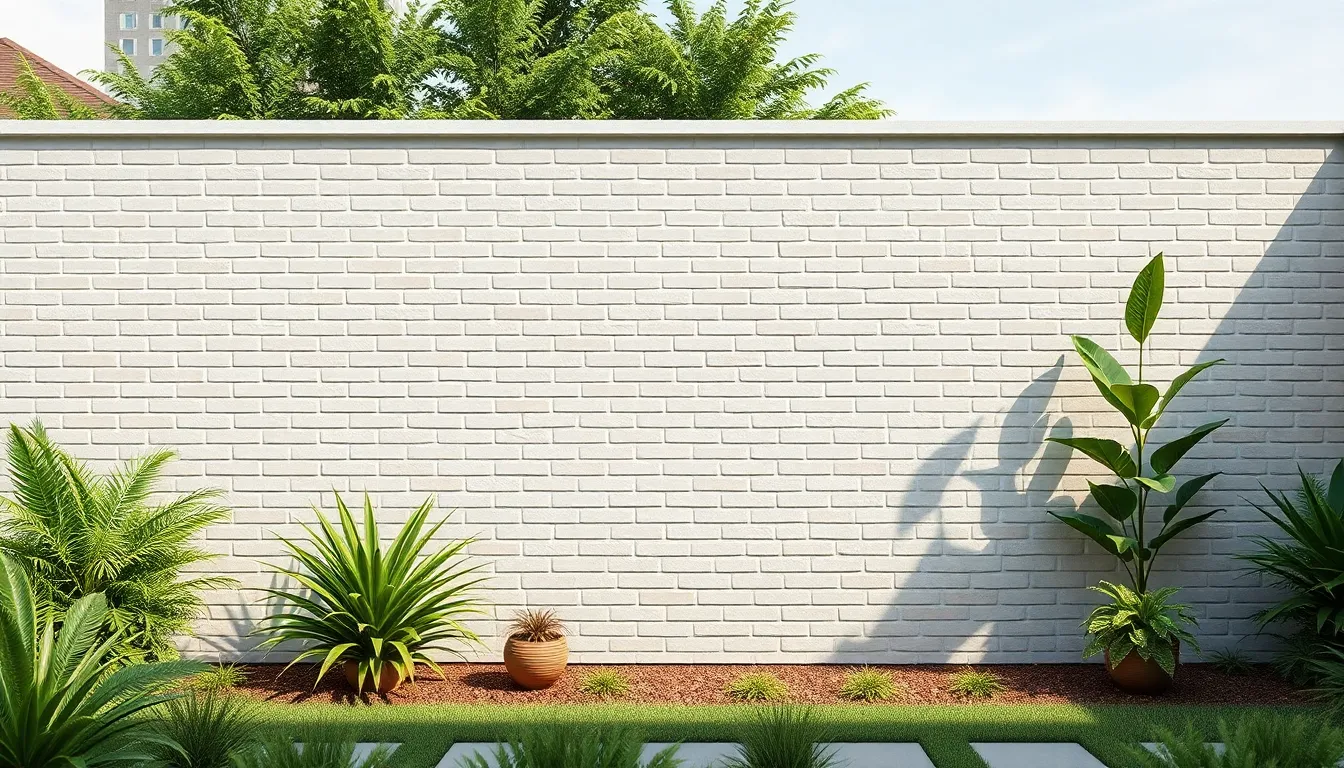
Modern minimalist approaches transform traditional brick walls into sleek design statements that complement contemporary outdoor spaces. These techniques focus on simplicity and clean aesthetics while maintaining structural integrity.
Clean Line Geometric Patterns
We recommend creating striking visual impact through carefully planned geometric arrangements that showcase brick’s natural beauty. Chevron patterns offer an elegant zigzag design that works exceptionally well for decorative accent walls measuring 2 to 4 feet in height. Herringbone layouts provide sophisticated texture while maintaining clean lines that complement modern garden designs.
Basketweave patterns create subtle geometric interest without overwhelming minimalist landscapes. These arrangements use alternating horizontal and vertical brick placements to form square patterns that add depth to garden walls. Stack bond layouts deliver the cleanest geometric appearance by aligning all joints vertically and horizontally for ultimate simplicity.
Monochromatic Color Schemes
We achieve cohesive modern aesthetics by selecting single color palettes that unify brick walls with surrounding industry elements. White painted brick walls create stunning backdrops for green foliage while reflecting light to brighten garden spaces. Gray brick selections in charcoal or light gray tones offer sophisticated neutral foundations that complement steel and concrete features.
Natural brick colors in consistent tones eliminate visual chaos while maintaining organic warmth. Uniform cream colored bricks provide soft contrast against dark mulch and plant materials. Black painted brick creates dramatic focal points that anchor modern garden designs with bold sophistication.
Contemporary Spacing Techniques
We carry out innovative spacing methods that create airy, light filled appearances in modern brick wall construction. Gap spacing techniques leave 1 to 2 inch intervals between individual bricks to reduce visual weight while maintaining structural stability. Alternating brick sizes combine standard bricks with half bricks to create rhythmic patterns that break traditional uniformity.
Stepped arrangements position bricks at varying depths to cast interesting shadows and create dimensional texture. Floating brick installations use hidden support systems to suspend individual bricks with consistent gaps for ultra modern appearances. These spacing approaches allow light penetration that prevents walls from appearing heavy or imposing in compact garden settings.
Decorative Brick Wall Feature Ideas
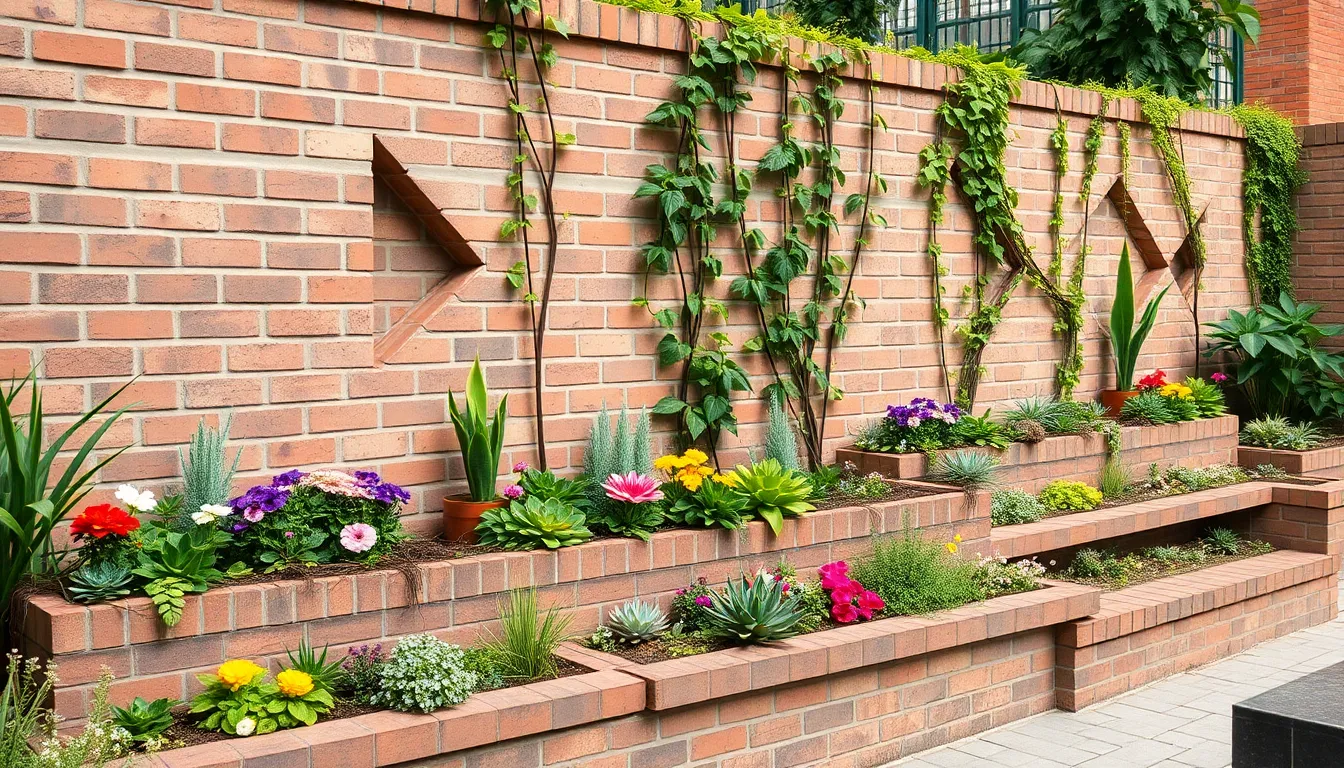
Beyond traditional structural applications, brick walls offer countless opportunities to incorporate functional and artistic elements that transform ordinary garden boundaries into stunning focal points.
Integrated Planter Box Designs
Built-in planters seamlessly blend functionality with aesthetic appeal by incorporating growing spaces directly into your brick wall construction. We recommend creating geometric planter boxes using square or rectangular configurations that maintain clean lines while providing ample space for flowers, succulents, or herbs. Circular brick planters offer a softer alternative that works particularly well for corner installations or as standalone features within longer wall sections.
Stepped planter arrangements create visual rhythm by varying the height and depth of integrated growing spaces throughout your wall design. These configurations work exceptionally well when you want to establish different microclimates for various plant types while maintaining structural integrity. Consider incorporating drainage systems during construction to prevent water damage and ensure healthy plant growth.
Tiered garden walls maximize planting opportunities by creating multiple levels within a single structure. We suggest using this approach when working with sloped terrain, as the natural grade change allows for more dramatic height variations between planter levels.
Built-In Seating Answers
Brick benches provide permanent seating that complements your garden’s architectural style while requiring minimal maintenance over time. We recommend building these structures approximately 18 inches high and 16 to 18 inches deep for optimal comfort, using the same brick pattern as your main wall for visual continuity.
Corner seating areas maximize space efficiency by utilizing wall intersections to create cozy gathering spots. These L-shaped configurations work particularly well in smaller gardens where every square foot matters, and they can incorporate storage compartments beneath the seating surface for garden tools or cushions.
Extended wall caps serve dual purposes by providing both weather protection for your brick structure and casual perching spots for garden visitors. We suggest creating these features at standard counter height (approximately 30 inches) when you want them to function as workspace areas for potting or garden maintenance tasks.
Artistic Cutout Patterns
Geometric cutouts transform solid brick walls into sculptural elements that play with light and shadow throughout the day. We recommend incorporating square, circular, or diamond-shaped openings in strategic locations to create visual interest while maintaining structural stability. These openings work particularly well as frames for specimen plants or garden art pieces.
Alternating brick patterns use contrasting colors or textures to create striking visual effects without requiring complex construction techniques. Consider using lighter colored bricks in exact rows or sections to establish horizontal bands, or incorporate different brick sizes to create texture variations across your wall surface.
Plant integration cutouts allow climbing vegetation to weave through your wall structure, creating living art that changes with the seasons. We suggest positioning these openings at varying heights and sizes to accommodate different plant growth patterns, ensuring adequate spacing for root development while maintaining wall integrity.
Height Variations for Garden Brick Walls
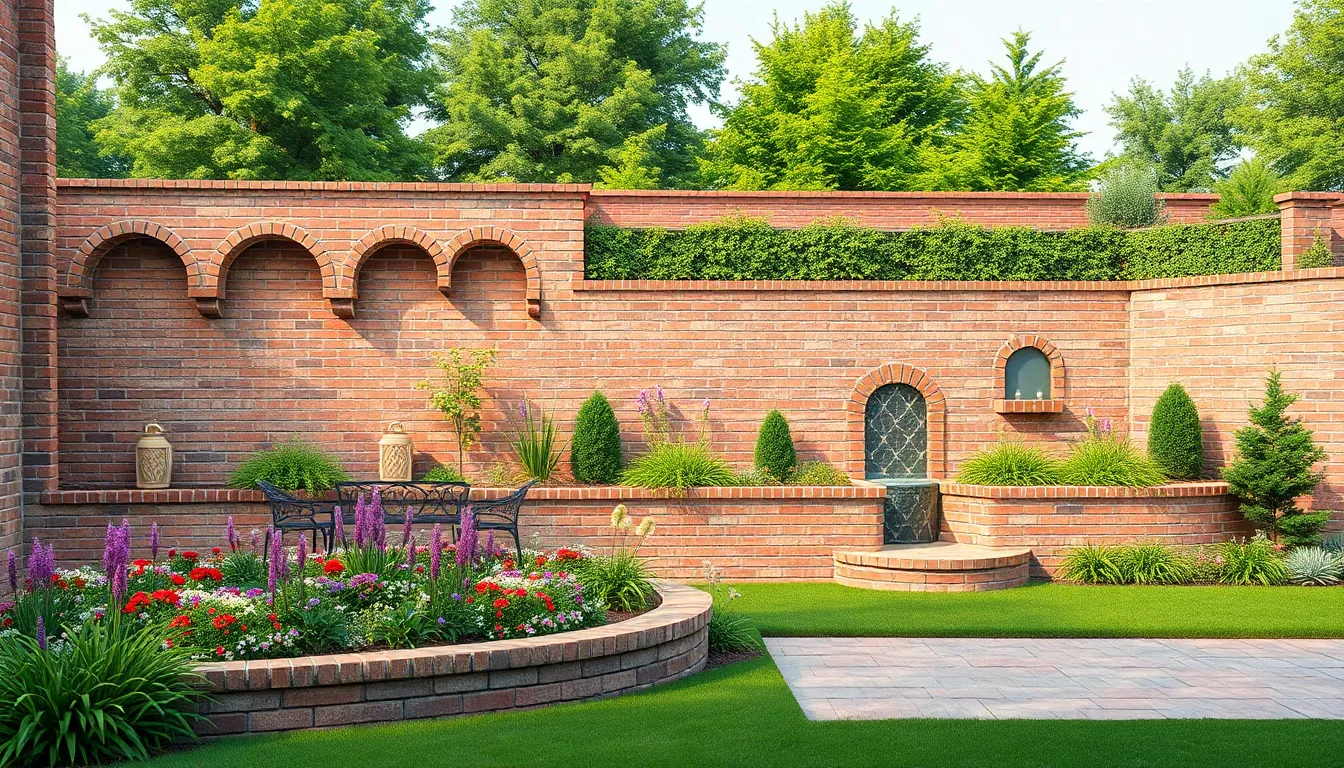
Different wall heights serve unique purposes in garden design and offer varying degrees of privacy, functionality, and visual impact. We can create stunning outdoor spaces by choosing the right height for our exact needs.
Low Border Wall Applications
Separation creates defined garden zones that organize outdoor spaces into distinct functional areas. We use low brick walls ranging from 12 to 24 inches to divide seating areas from vegetable patches, creating clear boundaries without blocking sightlines.
Retaining walls provide essential support for sloped gardens where soil erosion poses challenges. These shorter structures offer stability while maintaining the natural flow of the industry, making them perfect for terraced garden designs.
Planting opportunities multiply when we incorporate low walls as raised bed borders. The elevated design improves drainage and soil quality while creating comfortable working heights for gardening tasks.
Medium Privacy Screen Options
Mixed materials enhance visual appeal by combining bricks with wood panels or natural stone elements. We achieve balance between privacy and openness using walls that measure 3 to 5 feet in height, perfect for screening without creating fortress-like barriers.
Decorative elements transform functional walls into artistic garden features through strategic placement of arches or integrated water features. These medium-height structures provide partial privacy while maintaining connection with surrounding landscapes.
Strategic placement maximizes effectiveness when we position medium walls to block exact views or create intimate garden rooms. The ideal height allows conversation over the wall while providing seated privacy.
Tall Boundary Wall Answers
Boundary definition establishes clear property lines using walls that reach 6 to 8 feet in height. We create strong visual statements that clearly delineate our garden space while providing maximum privacy from neighboring properties.
Noise reduction becomes important with taller brick structures that effectively buffer sound from busy streets or adjacent activities. These substantial walls create peaceful garden sanctuaries where we can enjoy quiet outdoor moments.
Security enhancement increases through imposing height that deters unwanted access while maintaining attractive appearance. We balance protection with aesthetics by incorporating decorative caps or varied textures that soften the wall’s imposing presence.
Creative Brick Layout Patterns
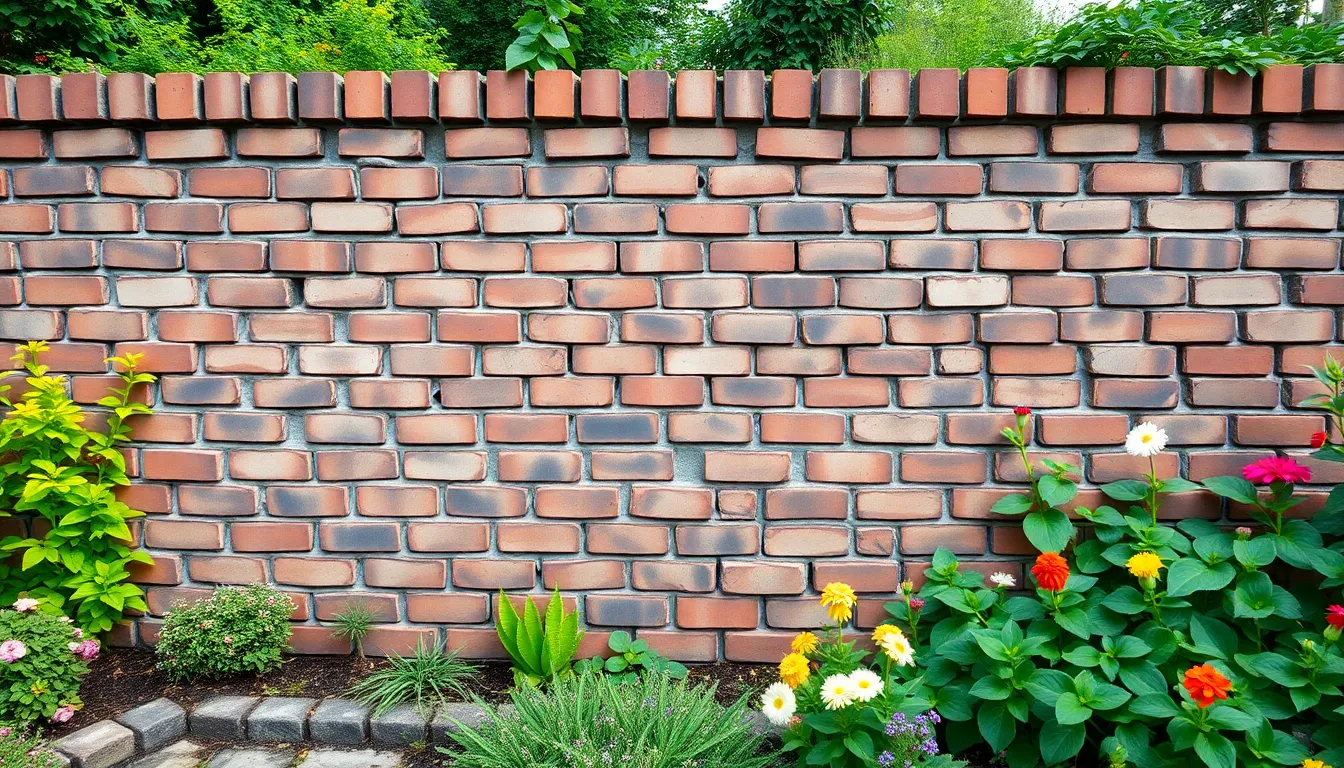
Moving beyond standard rectangular arrangements, we can transform garden walls into stunning visual masterpieces through strategic brick placement techniques. These innovative patterns add texture, dimension, and artistic flair to any outdoor space.
Basket Weave Design Elements
Basket weave patterns create incredible textural depth by alternating brick placement direction in a grid-like fashion. We achieve this stunning effect by laying pairs of bricks horizontally, then placing the next pair vertically, continuing this alternating sequence throughout the wall section.
This technique works exceptionally well for garden retaining walls where we want to add visual interest without overwhelming the surrounding industry. The interwoven appearance mimics traditional basket craftsmanship, making it perfect for cottage gardens or rustic outdoor spaces.
Installation requires careful planning since we must maintain consistent spacing between brick pairs to ensure the pattern remains uniform. We recommend starting with a detailed layout sketch to avoid alignment issues during construction.
Diagonal Diamond Configurations
Diagonal diamond patterns involve laying bricks at 45-degree angles to form geometric diamond shapes across the wall surface. We create these ever-changing elements by positioning bricks in alternating diagonal directions, forming distinct diamond outlines that catch light beautifully throughout the day.
This configuration adds sophisticated movement to otherwise static garden boundaries, making it ideal for feature walls or accent sections within larger brick structures. The diamond shapes work particularly well when we incorporate contrasting mortar colors to emphasize the geometric forms.
Planning becomes crucial with diagonal layouts since we need to calculate precise angles and cutting requirements for edge bricks. We suggest creating a small test section first to perfect the technique before tackling the entire wall project.
Mixed Size Brick Combinations
Using bricks of different sizes creates remarkable depth and visual complexity in garden wall construction. We can combine standard bricks with smaller accent pieces, or alternate between full-size and half-size bricks to generate unique patterns that break away from monotonous uniformity.
Smaller bricks work perfectly for creating intricate border details or filling spaces between larger structural elements. We often use them to form decorative bands that run horizontally through taller walls, adding layers of visual interest.
Larger bricks provide excellent structural foundation while contributing to rustic, substantial appearances that work well in traditional garden settings. We recommend mixing sizes strategically rather than randomly to maintain cohesive design flow throughout the completed wall.
This approach requires careful material planning since we need to calculate quantities for multiple brick sizes while ensuring adequate structural integrity across all wall sections.
Color and Texture Combinations
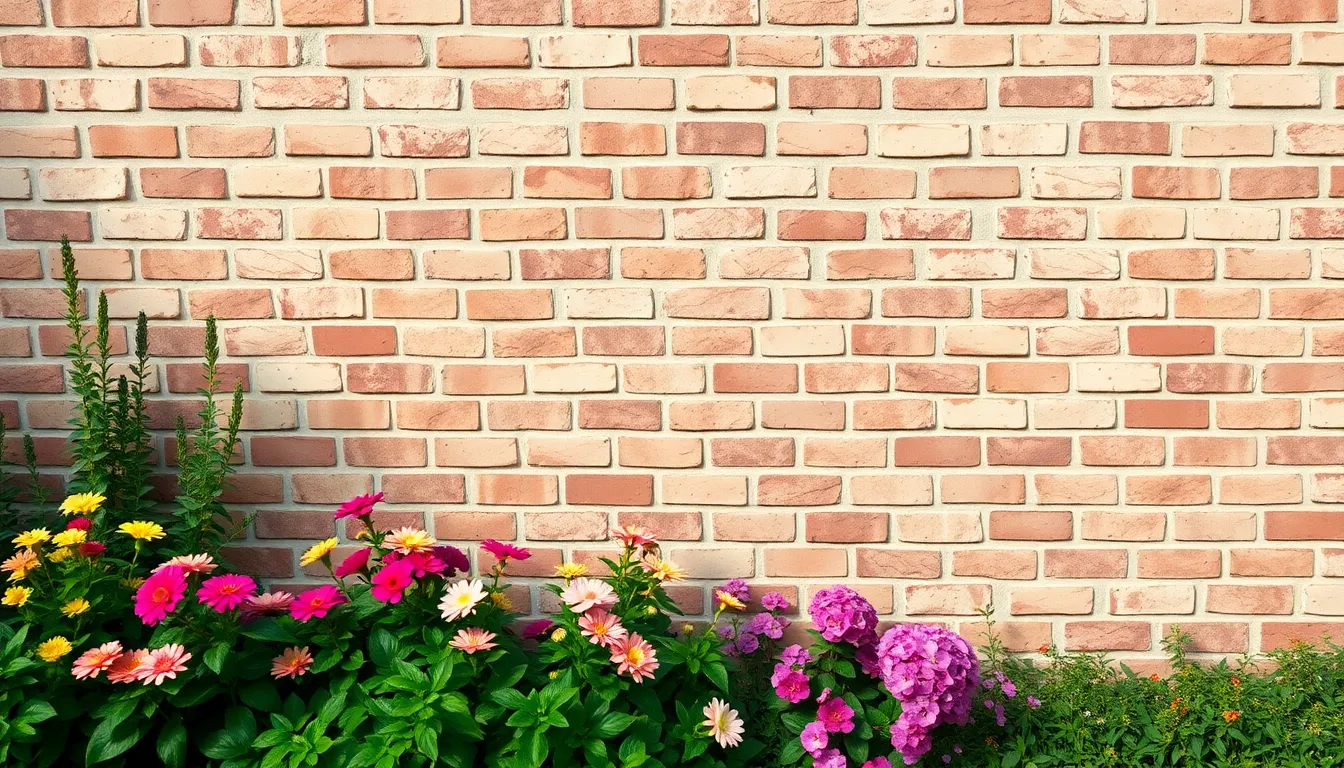
Creating visual depth in your garden brick wall requires thoughtful color and texture selections. We’ll explore how mixing different brick characteristics transforms ordinary boundaries into striking focal points.
Multi-Toned Brick Selections
Multi-toned brick patterns deliver exceptional visual appeal through strategic color variation. We recommend alternating between lighter and darker shades to create natural depth that draws the eye along your garden wall. Cream colored bricks paired with traditional red varieties produce a classic English garden aesthetic that complements flowering plants beautifully.
Graduated color schemes work particularly well for longer walls where monotony might become an issue. Starting with darker tones at the base and transitioning to lighter shades toward the top creates an uplifting visual flow. This technique makes walls appear taller while maintaining proportional balance with surrounding industry elements.
Random color placement offers a more organic appearance that mimics naturally weathered structures. Mixing burgundy, orange, and brown bricks in irregular patterns creates authentic aged character without waiting decades for natural weathering to occur.
Weathered and Aged Finishes
Weathered brick surfaces develop character through natural exposure to elements over time. We’ve observed that walls facing south and west develop the most distinctive patina due to increased sun and rain exposure. This natural aging process creates unique color variations that can’t be replicated artificially.
Aged finish applications provide immediate weathered appearance for new construction projects. Professional techniques include acid washing, sandblasting, and specialized staining processes that simulate years of natural weathering. These methods work particularly well on reproduction bricks designed to accept aging treatments.
Reclaimed brick options offer authentic aged character with established patina and texture variations. Salvaged bricks from demolished buildings carry historical charm that enhances traditional garden designs while supporting sustainable building practices.
Painted Brick Wall Options
Painted brick transformations completely alter wall appearance while maintaining structural integrity. We recommend using specialized masonry paints that allow moisture vapor transmission while providing long lasting color coverage. Limewash and mineral paints work exceptionally well for historical garden settings.
Bold color contrasts create dramatic focal points that complement exact garden themes. Deep navy or charcoal gray painted walls provide stunning backdrops for white flowering plants, while sage green complements herb gardens beautifully. These color choices help define distinct garden zones effectively.
Pattern painting techniques add artistic flair without complex construction requirements. Geometric designs, alternating color blocks, or accent bands can transform plain brick walls into custom garden features that reflect personal style preferences.
Functional Garden Brick Wall Features
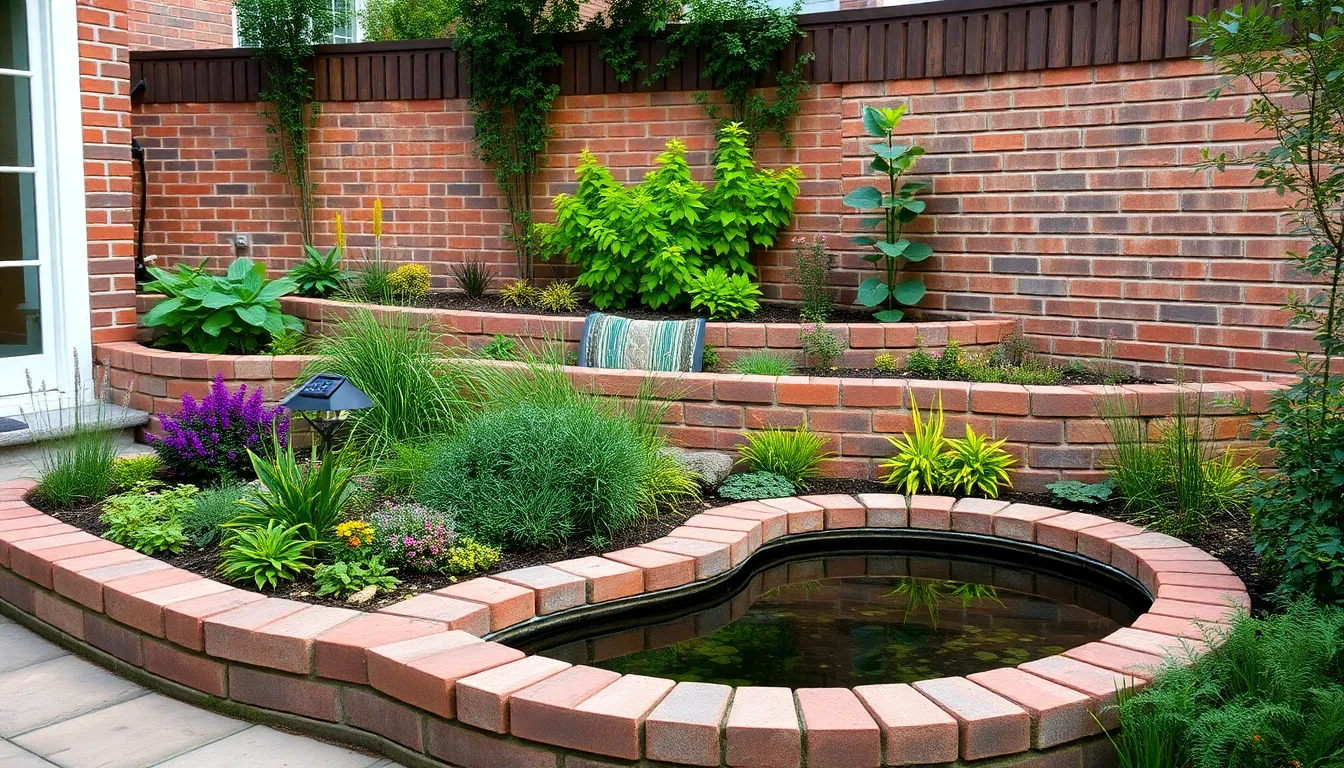
Garden brick walls offer practical answers that go far beyond simple boundaries, serving multiple purposes while maintaining their visual appeal.
Retaining Wall Applications
Slope stabilization becomes effortless with brick retaining walls, particularly in gardens with varying elevations. We recommend constructing these walls between 3 to 5 feet in height for optimal soil erosion prevention while maintaining structural integrity. Sloped gardens benefit tremendously from brick walls that create level planting areas and prevent water runoff damage.
Division and separation capabilities make low brick walls perfect for organizing different garden zones. We use these walls to separate vegetable patches from ornamental areas, create distinct seating zones, and establish clear pathways throughout the garden space. Low walls measuring 12 to 24 inches provide definition without blocking sightlines or overwhelming smaller outdoor areas.
Water Feature Integration
Ponds and fountains gain rustic elegance when constructed with brick materials that complement existing garden architecture. We’ve found that bricks create stunning pond borders and fountain bases, offering both durability and natural aesthetic appeal. Water features built with reclaimed bricks develop beautiful patina over time, improving their visual character.
Water element support relies on brick’s exceptional strength and moisture resistance properties. We construct brick foundations for larger water features like cascading waterfalls and tiered fountain systems. The porous nature of brick allows for proper drainage while maintaining structural stability around water installations.
Lighting Installation Ideas
Solar powered lights integrate seamlessly into brick wall designs, creating ambient illumination without electrical complications. We position solar fixtures along wall tops or embed them within mortar joints for subtle accent lighting. String lights can be anchored to brick walls using specialized masonry clips that won’t damage the surface.
Accent lighting placement transforms brick walls into dramatic nighttime focal points that highlight texture and architectural details. We install LED strip lights behind brick sections to create wash lighting effects, or use uplighting to emphasize wall height and dimension. Recessed lighting within brick planters illuminates both the wall structure and surrounding plantings.
DIY vs Professional Installation Considerations
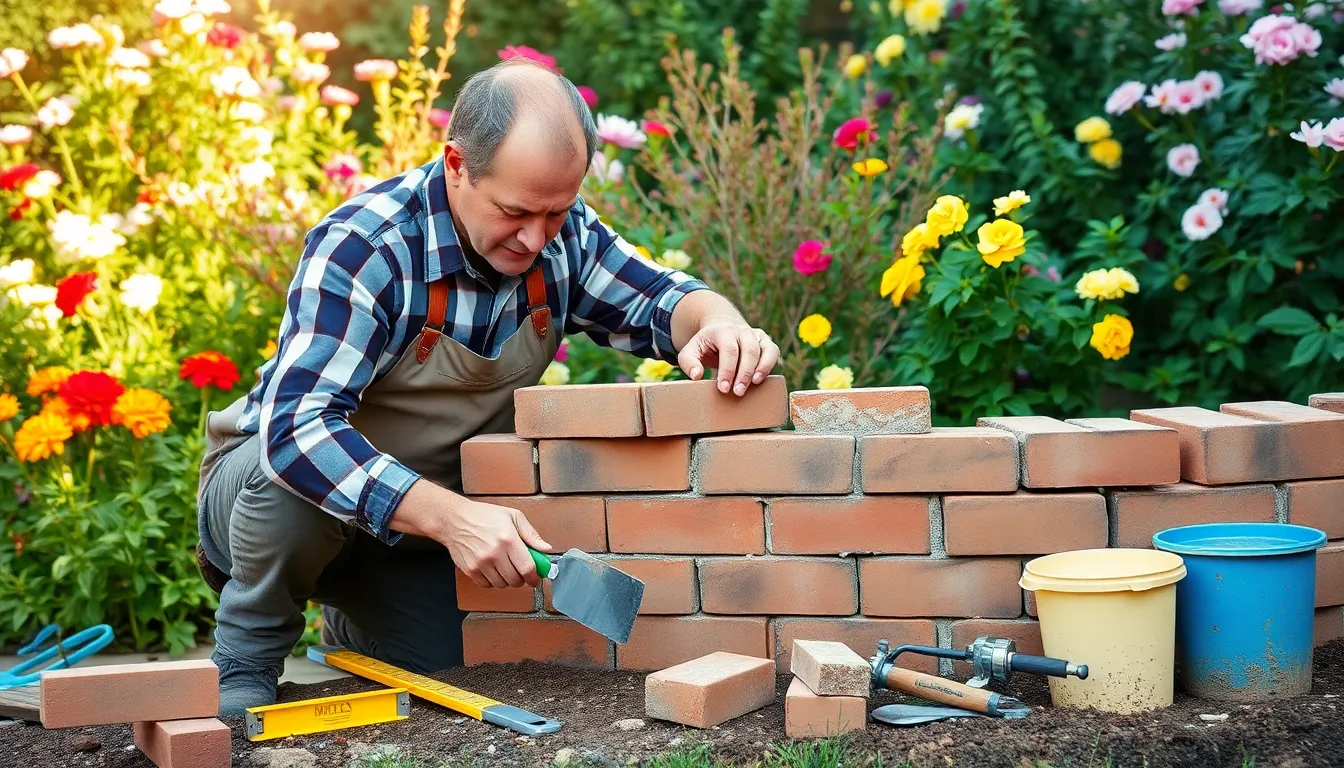
Choosing between DIY installation and professional masonry services significantly impacts your garden brick wall project’s outcome and budget. We’ll examine the key factors that determine which approach best suits your exact garden brick wall vision.
Skill Level Requirements
DIY garden brick walls demand basic building skills that most homeowners can develop with practice and patience. We need to understand mortar mixing ratios, proper brick laying techniques, and fundamental leveling principles to achieve professional-looking results.
Professional installation requires advanced masonry skills that take years to master completely. Licensed contractors possess structural understanding, precision craftsmanship abilities, and specialized knowledge about foundation requirements for different wall heights and soil conditions.
Beginners can successfully tackle low decorative walls up to 24 inches high using standard running bond patterns. Complex designs like herringbone patterns, curved walls, or retaining structures above 3 feet typically require professional expertise to ensure structural integrity and aesthetic appeal.
Tool and Material Needs
Essential tools for DIY brick wall construction include a quality trowel, 4-foot level, mortar mixing equipment, wheelbarrow for material transport, and brick cutting tools like chisels or wet saws. We also need string lines, rubber mallets, and pointing tools for finishing mortar joints.
Material requirements vary based on wall dimensions and design complexity. Standard materials include bricks (calculate 7 bricks per square foot), mortar mix, sand, gravel for foundations, and reinforcing rods for walls exceeding 4 feet in height.
Professional contractors bring specialized equipment like concrete mixers, laser levels, scaffolding systems, and diamond blade saws that ensure precision cuts and efficient installation. They also have access to bulk material pricing and can recommend optimal brick types for exact applications.
Cost Comparison Factors
DIY costs typically range from $10 to $25 per square foot for materials alone, making this approach attractive for budget-conscious homeowners. We save on labor expenses that usually account for 50% to 70% of total project costs.
Professional installation costs between $25 to $75 per square foot depending on design complexity, local labor rates, and material selections. Higher upfront investment ensures proper foundation work, structural integrity, and warranty protection against installation defects.
Long-term value considerations favor professional installation for structural walls, retaining walls, or complex decorative features. DIY mistakes can result in costly repairs, while professional work typically includes warranties and meets local building code requirements for permanent garden structures.
Maintenance and Longevity Tips
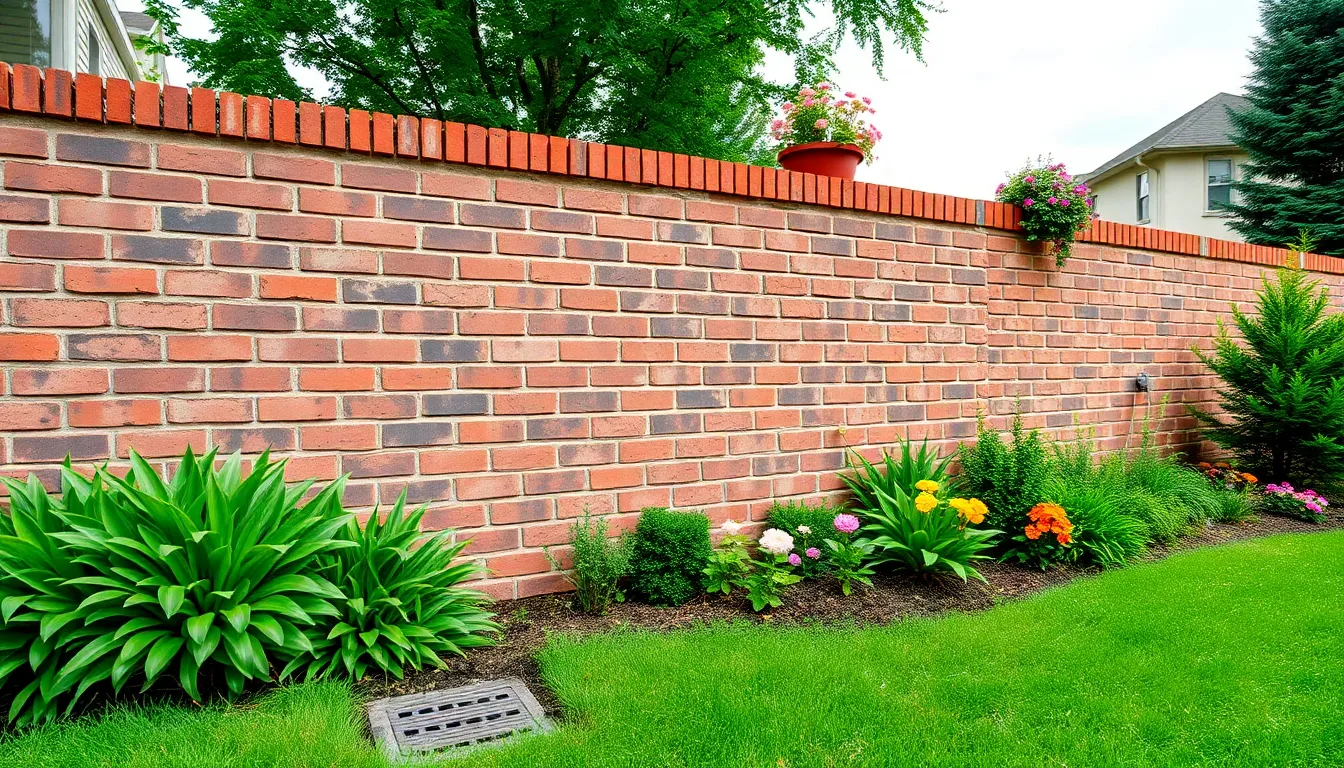
Proper maintenance extends the life of garden brick walls significantly while preserving their aesthetic appeal. We’ll explore essential care practices that keep your brick walls looking beautiful and structurally sound for decades.
Cleaning and Preservation Methods
Regular cleaning maintains the natural beauty of brick walls and prevents long term damage. We recommend using a mild detergent and water solution with a soft bristled brush for gentle weekly cleaning. Pressure washers work effectively on low settings but should never exceed moderate pressure to avoid mortar damage.
Sealant replacement requires consistent attention throughout the year. Inspect sealants every six months and replace them immediately when cracks or gaps appear. Fresh sealants prevent water infiltration that can cause structural problems and freeze damage during winter months.
Protective coatings shield bricks from environmental wear while maintaining their natural appearance. Apply breathable masonry sealers annually to prevent moisture penetration without trapping existing moisture inside the wall structure.
Weather Protection Strategies
Waterproofing creates a barrier against moisture damage that threatens brick wall integrity. Apply waterproof sealants specifically designed for masonry surfaces every two to three years. These products penetrate the brick surface and provide long lasting protection against rain and snow.
Drainage systems prevent water accumulation that can undermine wall foundations. Install French drains or gravel drainage channels around wall bases to redirect water away from the structure. Proper drainage reduces hydrostatic pressure and prevents soil erosion that weakens wall stability.
Winter protection strategies safeguard brick walls from freeze thaw cycles. Remove ice buildup promptly and avoid using salt based deicers that can damage mortar joints. Cover vulnerable areas with breathable protective fabric during extreme weather conditions.
Repair and Restoration Techniques
Regular inspections identify problems before they become major structural issues. Conduct thorough examinations twice yearly to spot cracks, loose bricks, or mortar deterioration. Address these problems immediately to prevent expensive repairs and maintain wall safety.
Mortar repair requires high quality materials and proper application techniques. Use mortar mixes that match the original composition and strength to ensure compatibility with existing materials. Professional help becomes necessary for extensive damage that affects wall stability or appearance.
Repointing maintains structural integrity while preventing further deterioration. Remove damaged mortar to a depth of at least one inch and replace it with fresh material that matches the original color and texture. This process should be completed every 20 to 30 years depending on weather exposure and wall condition.
Growth control prevents plant colonization that can damage brick surfaces over time. Keep walls dry through proper drainage and ventilation since damp conditions encourage moss and plant growth. Remove vegetation promptly and apply algaecides when necessary to prevent recurring growth problems.
Conclusion
Garden brick walls offer endless possibilities to transform our outdoor spaces into beautiful and functional environments. Whether we’re drawn to classic red brick charm or sleek modern designs these versatile structures can adapt to any garden style and budget.
The key lies in choosing the right height pattern and color combination that complements our existing industry. From decorative features to practical retaining walls we can create stunning focal points that serve multiple purposes.
With proper planning and maintenance our brick walls will provide decades of beauty and functionality. We encourage you to explore these creative possibilities and discover how the perfect brick wall can elevate your garden’s potential.
Frequently Asked Questions
What makes brick walls a good choice for outdoor spaces?
Brick walls offer exceptional durability and timeless appeal, making them perfect for outdoor environments. They provide multiple functions including privacy, defining garden boundaries, and enhancing aesthetic value. Unlike other materials, brick walls withstand weather conditions while maintaining their structural integrity and visual charm for decades.
How tall should garden brick walls be for different purposes?
Wall height depends on your specific needs. Low walls (12-24 inches) work well for defining garden zones and raised beds. Medium-height walls (3-5 feet) provide privacy screening and wind protection. Tall boundary walls (6-8 feet) offer maximum privacy, noise reduction, and security while defining property lines.
What are the most popular brick laying patterns for garden walls?
The running bond layout is most popular for taller walls due to its structural strength and ease of installation. Herringbone patterns create striking zigzag designs perfect for decorative shorter walls. Basket weave and diagonal diamond configurations add artistic flair and textural depth to outdoor spaces.
Can I build a brick wall myself or should I hire professionals?
Simple low decorative walls (under 2 feet) can be DIY projects with basic building skills. However, complex designs, retaining walls, or walls over 3 feet typically require professional expertise for structural integrity and building code compliance. Consider your skill level, available time, and local regulations before deciding.
How do I maintain my garden brick wall?
Regular maintenance includes cleaning with appropriate solutions, inspecting mortar joints annually, and repointing when necessary. Apply sealants every 3-5 years for weather protection. Ensure proper drainage around the wall base and promptly repair any cracks or loose bricks to prevent moisture damage and structural issues.
What design options work best for modern outdoor spaces?
Modern brick walls feature clean geometric patterns, monochromatic color schemes, and innovative spacing techniques. Consider gap spacing, alternating brick sizes, or stepped arrangements for lighter, more dimensional looks. White, gray, and natural tones create cohesive aesthetics that complement contemporary landscape designs.
How much does it cost to build a garden brick wall?
Costs vary significantly based on wall height, length, design complexity, and location. DIY projects typically cost $15-25 per square foot for materials. Professional installation ranges from $25-50 per square foot. Decorative features, drainage systems, and site preparation can increase costs. Always get multiple quotes for accurate pricing.
What additional features can I incorporate into brick walls?
Brick walls can include integrated planter boxes, built-in seating, artistic cutout patterns, and lighting installations. Water features like fountains complement brick materials beautifully. Consider incorporating different textures, colors, or mixed-size combinations to create unique focal points that enhance your garden’s overall design.

